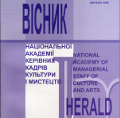ПІСНІ С. МОНЮШКА ДЛЯ ВИСОКОГО ГОЛОСУ ТА ПОЛІЖАНРОВА ПАЛІТРА ЇХ СТИЛЬОВОГО ВИЯВЛЕННЯ
S. MONIUSZKO'S SONGS FOR HIGH VOICES AND MULTI-GENRE PALETTE OF THEIR STYLISH EXPRESSION
Author(s): Qingqing YingSubject(s): Cultural history, Music, 19th Century, History of Art
Published by: Національна академія керівних кадрів культури і мистецтв
Keywords: song genre; musical genre; style in music; Biedermeier; realism-verism;
Summary/Abstract: The purpose of the research is to trace the Biedermeier background of the expressiveness of S. Moniuszko's Songs in their borderline to the musical realism-verism of the middle of the 19th century, using the example of the songs for high voice from the collection "Pieśni wybrane", 1, na głos wysoki (Polskie Wydawnictwo Muzyczne: Kraków, 1972), which timbre-register corresponds to the lyric soprano of the author of this essay. The methodological basis is the intonation approach of the school of B. Asafyev in Ukraine, represented, among other things, by the works of O. Markova, O. Muravska, Yu. Oleinikova, other authors, in which the basic method of analysis is stylistic comparative, musicological holistic analysis with hermeneutic approaches, as well as the historical-biographical method from the perspective of the "intellectual biography" of the subject of the study. The scientific novelty of the work is determined by the author's primacy of unfolding the stylistic vision of Moniuszko's Songs on its Biedermeier basis in relation to the nascent method of musical realism-verism. Also innovative is the analysis of the named Songs from the perspective of the stated stylistic interpretation of the expressiveness of the works of the great Polish composer. Conclusions. The 12 analysed Songs by S. Moniuszko within the stylistic Biedermeier attribution demonstrated the breadth of identifying signs of a small form – from monologue-serenades, three-strophe type bar-form to the "minimalism" of genre couplets. This gives birth to Biedermeier's characteristic combination of high Europeanism and demonstratively simplified "provincialisms" (the latter due to the genre of Kraków and Mazurka). The compensability of the parts of the voice and the piano gives the sound of the vocal-instrumental model of the madrigal-motet, which became one of the means of revealing the realism of life's "polyphony" (see the madrigal genre in the French lyric opera of S. Gounod) together with frank folkloristic findings that indicative of the aesthetics of musical realism of the middle of the 19th century.
Journal: Вісник Національної академії керівних кадрів культури і мистецтв
- Issue Year: 2023
- Issue No: 3
- Page Range: 258-263
- Page Count: 6
- Language: Ukrainian

